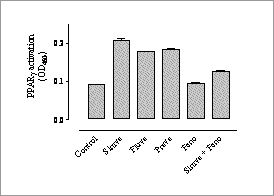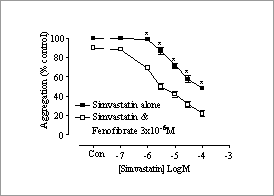Anti-thrombotic effect of statins in human platelets are associated with activation of PPAR receptors: implications for cardioprotective properties Statins are a group of hypolipidaemic drugs which work by inhibiting the key enzyme in cholesterol synthesis, 3-hydroxy-3-methyl-glutaryl-coenzyme A ( HMG-CoA) reductase. Beyond their lipid lowering abilities, statins are capable of decreasing an individuals risk of heart attack or stroke. The mechanisms behind the cardioprotective effect of statins are incompletely understood. In the current study we demonstrate that a range of clinically relevant statins inhibit the aggregation of human platelets and activate PPARγ . PPARγ is a nuclear receptor which modulates the transcription of known downstream target genes in nucleated cells. Despite having no nucleus platelets have previously been shown to contain PPARγ and the related protein, PPARβ , activation of which inhibits aggregation (Akbiyik et al; Ali et al.). Our current observations with statins provide an explanation and a mechanism by which statins provide cardio-protection in man. Human blood was collected by venepuncture into citrated tubes (1:9 v/v) and responses measured using electrical impedance aggregometry. Aggregation was induced by addition of ADP (10-5M) with maximal responses recorded after 15 min. PPAR activation was determined using a Transfactor assay from BD Biosciences.
Figure 1. (A) PPARγ activation in platelets, drugs at 10-5M. (B) Effects of simvastatin and fenofibrate on platelet aggregation in whole blood. Data is mean ± s.e.m. for n=3 determinations. * p<0.05; two-way ANOVA. We have evidence to show that statins (10-5M) activate PPARγ (Figure 1A) and inhibit platelet aggregation. The effects of simvastatin (10-7– 10-4M) were inhibited by the PPARγ antagonist, GW9662 (10-5M; p<0.05 n=3). The additive effect of simvastatin and fenofibrate on platelet aggregation was greater than that of simvastatin alone (Figure 1B). These observations may help to explain the clinical effects of statins and fibrates.
Akbiyik et al. (2004) Blood 104: 1361-1368 This work was funded by the Joint Research Board of St Bartholomew’s Hospital, London. |



